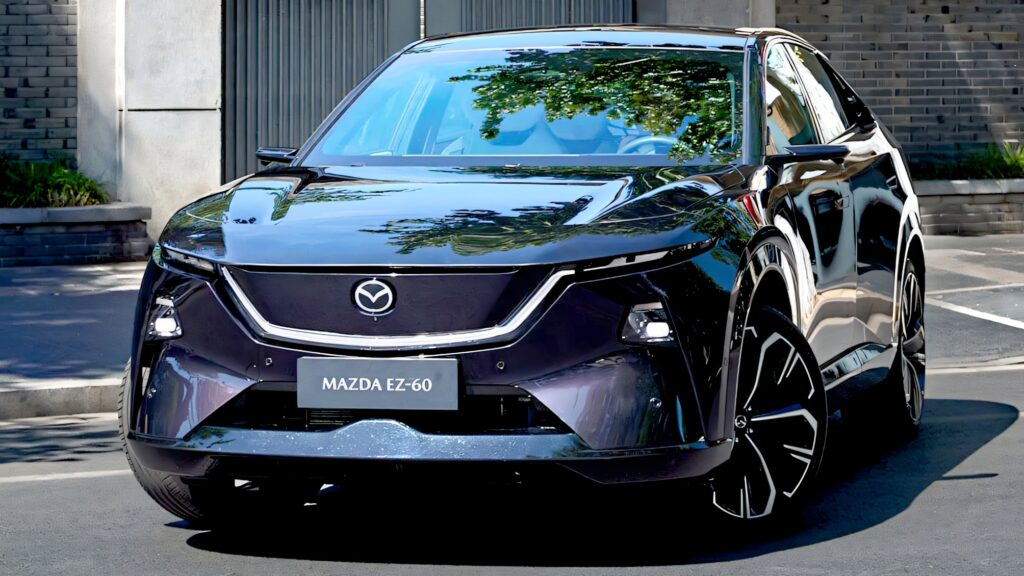
- Mazda’s revamped Japanese plant can produce PHEV, hybrid, gas, diesel, and EV models.
- Automatic guided vehicles are used throughout the factory and help install powertrains.
- The company can quickly adjust production levels at the site depending on EV demand.
Mazda has faced some criticism for its slow roll-out of compelling EVs. While the new EZ-6 sedan and EZ-60 SUV have garnered attention, they are primarily aimed at the Chinese market and Europe, and both are based on Chinese models. However, that’s about to change.
var adpushup = window.adpushup = window.adpushup || {que:[]};
adpushup.que.push(function() {
if (adpushup.config.platform !== “DESKTOP”){
adpushup.triggerAd(“0f7e3106-c4d6-4db4-8135-c508879a76f8”);
} else {
adpushup.triggerAd(“82503191-e1d1-435a-874f-9c78a2a54a2f”);
}
});
The company plans to launch its own EVs soon, unrelated to the EZ models shown here. The first of these new vehicles is scheduled to go into production in 2027 at the company’s existing Hofu 2 assembly plant in Japan. Unlike some rivals, Mazda won’t be building a separate EV production line to make it happen.
Flexible Production, Lower Costs
Instead of following the traditional route of investing in an entirely new EV manufacturing process, Mazda has developed a flexible system that allows its electric vehicles to be made alongside hybrid, gas, diesel, and plug-in hybrid models. According to Mazda officials who spoke to Auto News, this innovation will help slash investment costs by a whopping 85%, all while reducing production lead time by 80%.
“A dedicated EV line isn’t necessary because our lines can already accommodate mixed production,” Taketo Hironaka, managing executive officer in charge of production engineering, told Autonews. “This plant is at the cutting edge of Mazda’s manufacturing.”
Read: Mazda’s New Pure Electric SUV Has Spilled Its Secrets
The Hofu H2 site currently produces the CX-60, CX-70, CX-80, and CX-90. It no longer uses fixed conveyors; instead, it utilizes flat pallet platforms that slide across the factory floor. Automatic guided vehicles are then used to transport a vehicle’s powertrain and guide it into place, regardless of whether that vehicle is a PHEV, a diesel, or an EV. This flexible setup also means Mazda only needs seven days to extend a production line, whereas it previously took six weeks.

Mazda is also adopting a lean asset strategy that will enable it to maximize the utilization of its existing production facilities. According to the managing executive officer in charge of production engineering at the Hofu 2 factory, Taketo Hironaka, Mazda will keep capacity utilization at the factory near 100%. The flexibility will also allow it to quickly adjust production levels of hybrids and EVs should demand for EVs ever temporarily slump or spike.
“Doing mixed production means our BEV ratio will change according to customer demand at a given time,” Hironaka said. “We may see a BEV ratio of 100 percent, or it could be 0 percent. We have been able to build such a flexible production system this time. For a small player like us, we think using our production lines 100 percent by employing mixed production is a smart way to go. Under our lean asset strategy, we will maximize the use of our existing production facilities to ride out the initial stages of shift to electrification.”
var adpushup = window.adpushup = window.adpushup || {que:[]};
adpushup.que.push(function() {
if (adpushup.config.platform !== “DESKTOP”){
adpushup.triggerAd(“bb7964e9-07de-4b06-a83e-ead35079d53c”);
} else {
adpushup.triggerAd(“9b1169d9-7a89-4971-a77f-1397f7588751”);
}
});
Tariffs and the U.S. Market
Efficient production isn’t just about cost-cutting, it’s also a buffer against external pressures. Mazda is bracing for the impact of the United States government’s new 25 percent tariff on vehicles and parts, a move that could hit the company hard in its largest market outside of Japan.
“The 25 percent figure is outrageous,” Hironaka told the publication. “We will control what we can. “The key is not having any waste in fixed costs and capital investment. In that sense, this Hofu No. 2 plant is a plant that is at the forefront of our approach,” he added.
var adpushup = window.adpushup = window.adpushup || {que:[]};
adpushup.que.push(function() {
if (adpushup.config.platform !== “DESKTOP”){
adpushup.triggerAd(“bb7964e9-07de-4b06-a83e-ead35079d53c”);
} else {
adpushup.triggerAd(“9b1169d9-7a89-4971-a77f-1397f7588751”);
}
});
